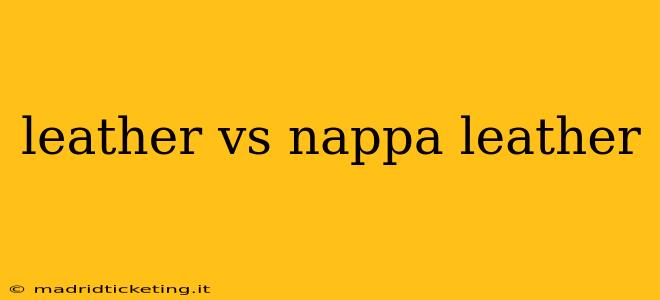Choosing the right leather for your next purchase—whether it's a jacket, handbag, or car seats—can be tricky. Two popular options often leave consumers wondering: leather and nappa leather. While both are genuine leather, there are key differences in their properties, feel, and price that significantly impact their suitability for various applications. This comprehensive guide will delve into the nuances of leather versus nappa leather, helping you make an informed decision.
What is Leather?
Before diving into the specifics of nappa leather, let's establish a basic understanding of what constitutes "leather." Leather is a natural material created by tanning animal hides, primarily from cows, sheep, goats, or pigs. The tanning process preserves the hide, making it durable and resistant to decay. However, "leather" is a broad term encompassing various types, each with distinct characteristics determined by the animal's origin, tanning methods, and finishing processes. This variety in manufacturing contributes to the wide range of leather qualities and prices available in the market.
What is Nappa Leather?
Nappa leather is a specific type of leather known for its exceptionally soft and supple texture. It's typically made from the finest, most supple parts of sheepskin or goatskin hides. The tanning process for nappa leather is often more refined, resulting in a luxurious feel and a smooth, almost silky surface. The unique smoothness is achieved through careful processing, often employing techniques that minimize the appearance of natural grain. This results in a more consistent and even surface compared to other types of leather.
What are the Key Differences Between Leather and Nappa Leather?
The core differences lie in the manufacturing process, the resulting texture, durability, and price point.
Texture and Feel
- Leather: The texture of leather varies greatly depending on the type and tanning process. It can range from smooth to grainy, thick to thin, and soft to stiff. Full-grain leather retains the natural grain of the hide, while top-grain leather has the top layer of the hide removed.
- Nappa Leather: Nappa leather consistently boasts a remarkably smooth, soft, and supple texture. Its luxurious feel is a key selling point.
Durability
- Leather: Durability in leather can vary significantly. Full-grain leather, generally considered the most durable, is resistant to scratches and wear. Other types of leather may be more susceptible to damage.
- Nappa Leather: While incredibly soft and luxurious, nappa leather tends to be less durable than full-grain leather. It's more prone to scratches and scuffs due to its delicate nature and smooth surface.
Price
- Leather: Leather prices vary widely based on the type, quality, and tanning process.
- Nappa Leather: Nappa leather is generally more expensive than other types of leather due to its higher-quality raw materials and more meticulous manufacturing process.
Is Nappa Leather Worth the Price?
Whether nappa leather is "worth it" depends entirely on your priorities and intended use. If you prioritize extreme softness, a luxurious feel, and a smooth, consistent appearance, then the higher price tag might be justified. However, if durability and resistance to wear and tear are paramount, you might find other types of leather more suitable.
How Durable is Nappa Leather?
Nappa leather's softness comes at the cost of reduced durability compared to full-grain leather. It's more susceptible to scratching and scuffing. Proper care and maintenance are essential to prolong its lifespan.
How to Clean Nappa Leather?
Cleaning nappa leather requires a gentle approach. Avoid harsh chemicals and abrasive cleaners. Use a specialized leather cleaner and conditioner to maintain its softness and appearance.
What is the Difference Between Nappa and Full Grain Leather?
The primary difference lies in the texture and durability. Nappa leather is incredibly soft and smooth due to its processing, while full-grain leather is more durable and retains the hide's natural texture. Full-grain is generally more resistant to scratches and wear.
What are the Best Uses for Nappa Leather?
Nappa leather's ideal applications include items where softness and luxurious feel are prioritized over extreme durability. This makes it suitable for gloves, high-end apparel, luxury handbags, and interior car components in premium vehicles.
By understanding the distinctions between leather and nappa leather, you can choose the material that best suits your needs and budget. Remember to consider your priorities—durability, softness, aesthetics, and budget—when making your selection.

